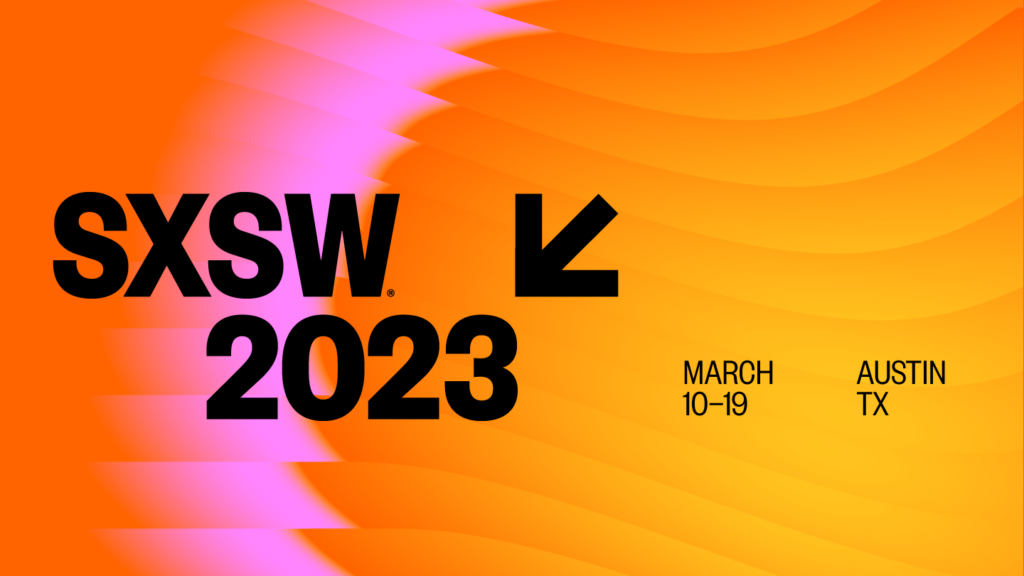It’s hard to believe, but I have not been to South by Southwest (SXSW) for more than five years. After going every year for six years, SXSW was finally on my agenda again in 2023!
Marc Segers from AIP Publishing and Lori Carlin, Chief Commercial Officer, at Delta Think were there too. One tip that I didn’t mention last time was that I have always found attending SXSW is better in a group. There is no way you can cover everything yourself. It’s fun to catch up with others and get their perspectives and to learn about things you didn’t get to see. It was even more fun after a long, long, time of virtual events.

The scale of SXSW is mind-blowing. This year there were more than 20 tracks of content, ranging from Media Industry, to Start-ups, to Culture, to Psychedelics. Although the film and music sessions look amazing, I’m there for SXSW Interactive.
Attending about a dozen sessions over three days, may seem light – the way we are all so used to cramming in as much as we can into every minute – but it was perfect for me. Each session needed its own time for reflection. This was one of the themes I heard repeatedly: we need to build in time for reflection, digestion, and connecting the dots. We are all too busy.
This was one of the themes I heard repeatedly: we need to build in time for reflection, digestion, and connecting the dots. We are all too busy.
There were many sessions related to XR (extended reality). XR is basically an umbrella term that covers VR (virtual reality), AR (augmented reality), and MR (mixed reality). Marc attended a few of these sessions and reported rumors of Apple getting in this space this year. Sessions also stressed not to recreate our current experience, but to do new things that can only be possible in XR.
With the eruption of ChatGPT and other generative tools, AI was also a big topic. According to The Guardian, ChatGPT was at 100 million users in 5 days, an unprecedented speed. I didn’t go to any of these sessions because this has so permeated the news and there are so many interesting tools to play with, I felt my SXSW experience was better focused elsewhere. But there was no denying the buzz all around the conference center and session venues.
Another theme, somewhat ironically in such a complex and sprawling venue, was simplicity.
Another SXSW theme, somewhat ironically in such a complex and sprawling venue, was simplicity. An example of this was the session Only Deep Simplicity Can Fix the Complexity Crisis presented by Nick Long, Global Lead for Design & Creative Tech at Accenture Song. Nick spoke about the Complexity Tax that exists as customers face increasing options and decreasing “middle men” to help sort them. He started with an example of how he had to download 3 apps and visit a website to get his boarding pass to Austin, because of the complexity of how airfares are sold and booked. All of the three apps were well designed. It was the integration between them for this simple use case (get my boarding pass) that was the issue. He also cautioned us to align our brand promises (art) with how we measure our performance (math).
Customer centricity is almost more than a theme at SXSW, it’s a foundation.
Customer centricity is almost more than a theme at SXSW, it’s a foundation. Like the Nick Long session, there were many sessions on customer/user centric behaviors and design. Two of the most interesting to me were Fall in Love with the Problem with Waze co-founder Uri Levine and Unleashing the Entrepreneur in Everybody with Mark Cuban, from Shark Tank, and Isabella Guzman, Administrator of the US Small Business Administration.
Both sessions highlighted essential aspects of entrepreneurship and product development. Uri, from Waze, was adamant that the only way to be a successful entrepreneur was to not only love the problem you are trying to solve, but to love the journey to solve it, and to be willing to sacrifice everything. He also echoed a common refrain we’ve been hearing in product development for a while: Good enough and free can go a long way, and iterating to get the features right is crucial.
Uri framed the problem as the North Star of the journey. It was what made the story compelling, for designers, users, and investors. He also warned us against telling our story in terms of features and functions. Instead, focus on impact. No one cared about an AI crowdsourced navigation system — they cared that Waze was going to help them avoid traffic jams!
Uri, from Waze, was adamant that the only want to be a successful entrepreneur was to not only love the problem you are trying to solve, but to love the journey to solve it, and to be willing to sacrifice everything.
Mark and Isabella spoke of similar concepts but were more focused on the role of the entrepreneur rather than the development of the product. Isabella highlighted Small Business Administration resources. Mark and Isabella coached several entrepreneurs from the audience working through a myriad of issues they faced from funding, to resource constraints, to branding and communication issues.
Both sessions spent some time talking about teams, dealing with communication issues and ego problems within the team, and the importance of hiring the right people (and being willing to fire them if necessary). Mark Cuban asked entrepreneurs that failed why they failed — many said it was because they didn’t have the right team. Then he asked them when they knew that — almost all of them said “right away.” Uri suggested entrepreneurs should evaluate new hires after 30 days and ask themselves, “If I knew before hiring this person what I know now, would I still hire them?” He said if the answer was no, they should be fired immediately.
…entrepreneurs should evaluate new hires after 30 days and ask themselves “If I knew before hiring this person what I know now, would I still hire them?”
Moving on….
“Curiosity is the new superpower” and asking questions is critical, according to the team from Now What. They presented my favorite session (Lori and I attended together and it was her favorite too!): Creating Cultures of Curiosity
They invested $1m in studying the art and science of questions, interviewing people in 100 different professions to find out how and why they ask questions, what makes a better question, and what you can do to create a culture that promotes inquiry. In reviewing the results, they came up with several best practices and also identified 4 styles of curiosity (take the test, it’s fun and informative!). Some of their findings:
- Better questions use heat to cook, not burn. Avoid “questions” that are designed to prove the other person wrong, especially when talking about heated subjects. Instead, turn them into a story-teller. Find out how they’ve come to believe something versus debating what they believe.
- Better questions break us out of our scripts. Ask the question that goes deeper. If someone is in a hospital, you don’t ask “How are you?” — they’re in the hospital! Instead, ask deeper questions “What has been on your mind today?”
- Questions are a tool of the powerful. We all start out asking lots of questions. Then the world shows us that powerful people ask questions (teachers, police, doctors, etc.) of others. We may even hear our colleagues ask permission (“May I ask you a question?) before engaging in inquiry. We need to shift the power dynamic to make questions a normal part of life for everyone.
- Invest in questioning the question. What else do you need to know to give someone something they need? The example used here was someone in the military being asked a question by his commanding officer. He responded with a series of questions to help insure he was giving the officer precisely what they needed in the right time frame.
So what? The fundamental point is that while curiosity has always been important, it is now more critical then ever. We can no longer flatly extrapolate the future from the past. Evolution is happening faster (see acquired user rate of ChatGPT earlier in this post). If we aren’t harnessing our ability to learn and put that learning to the test, we are in danger of falling behind or becoming extinct.
If we aren’t harnessing our ability to learn and put that learning to the test, we are in danger of falling behind or becoming extinct.
There was just too much happening at SXSW to cover in this post, but I hope you’ve gotten a flavor of what happens at SXSW Interactive and how it is relevant to our industry and organizations.
I fed in all of my and Marc Segers’ notes to AI-Pro and asked it to identify 5 key SXSW themes. Then I asked it to prioritize those themes and here’s what I got.
- Customer-centricity and user experience as critical factors for success
- Love for the problem as the driving force for entrepreneurship
- Community-first approach in business; Fostering connection and authenticity in building community
- Resilience and willingness to learn as essential qualities for success
- The power of questions, curiosity, and active listening in driving growth
Not too bad. Of course this is based on what Marc or I attended not all of SXSW.
Let me leave you with my most favorite quote from the conference. It was from the session Leading with Good Power, a conversation with Ginni Rometty, former IBM Chairman and CEO.
“Growth and comfort will never co-exist.”
I don’t know about you, but I’d rather be growing than be comfortable!

